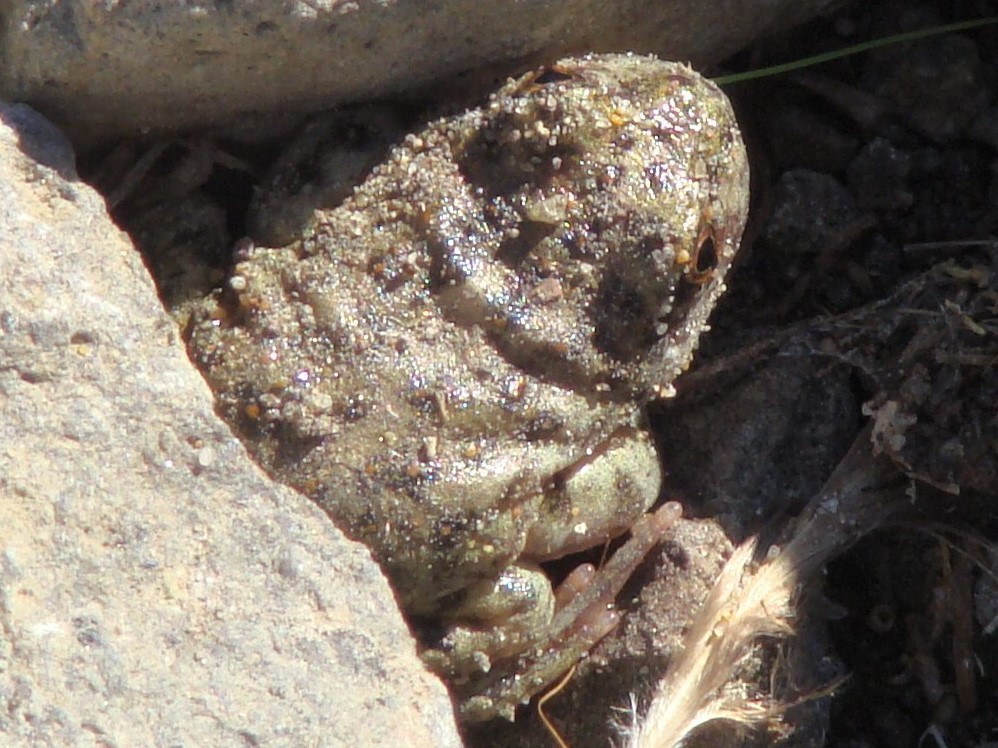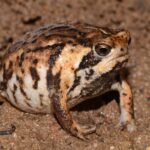- Exploring the Secretive World of Atelognathus reverberii: Patagonia's Enigmatic Amphibian
Exploring the Secretive World of Atelognathus reverberii: Patagonia’s Enigmatic Amphibian#
Beneath the windswept plains and craggy landscapes of Patagonia lies a quiet secret, a modest yet captivating amphibian known as Atelognathus reverberii. This enchanting frog species has lived its life largely hidden from human eyes, thriving in remote corners of Argentina’s rugged southern terrain. Unassuming at first glance, this humble amphibian hints at larger ecological stories about climate change, habitat conservation, and the interconnectedness of life. With fascinating behaviors and delicate adaptations, Atelognathus reverberii symbolizes why even the smallest creatures warrant our attention and admiration.
Dive into the mossy marshlands and shallow lagoons, follow the faint echoes of gentle vocalizations, and let us journey together into the mysterious world of Atelognathus reverberii, Patagonia’s understated jewel.
Taxonomy and Classification#
Atelognathus reverberii belongs to the broader family Batrachylidae, encompassing a variety of fascinating species adapted to temperate regions in the Southern Hemisphere. Scientifically classified within the genus Atelognathus, this frog shares its lineage with several equally intriguing species, all characterized by unique morphological features and behaviors adapted intricately to their specific microhabitats.
This frog was first described scientifically in detail by the acclaimed Argentine herpetologist José Miguel Cei in 1969, who recognized its subtle distinctions from closely related species. Since its discovery, it has become an intriguing subject for amphibian researchers, serving as a vital piece in understanding broader ecological contexts surrounding Patagonian wetland ecosystems.
Natural Habitat#
Geographic Range and Distribution#
The geographical tapestry of Patagonia, Argentina’s wild and untamed region in the south, forms the heartland of Atelognathus reverberii. Predominantly situated within the province of Chubut, this species occupies a comparatively tiny fragment of the vast Patagonian landscape, rendering it endemic and exclusive to select freshwater ecosystems.
These frogs favor shallow, freshwater wetlands nestled within the steppe ecosystems. In these marshy habitats, patches of reeds and grasses punctuate reflective lagoons, creating a rich mosaic of vegetation that shelters these sensitive amphibians. The local climate, shaped intensely by relentless winds, seasonal rainfall, and stark temperature fluctuations, gives rise to habitats uniquely suited to this highly adapted species.
Habitat Preferences and Adaptations#
Atelognathus reverberii thrives in clear freshwater lagoons and marshes characterized by both submerged and emergent vegetation. These habitats offer the necessary resources to support the frog’s complex life cycle, including ample food supply, shelter from the elements, and ideal breeding conditions. The specialized vegetation also provides camouflage, essential for protection against their predators.
Interestingly, these amphibians showcase remarkable adaptability to Patagonia’s harsh environmental extremes. During colder months, they retreat beneath mud and vegetation, reducing their activity significantly. This strategy makes them relatively resilient against seasonal fluctuations but intensifies their vulnerability during prolonged drought or climatic shifts.
Physical Characteristics#
At first glance, Atelognathus reverberii seemingly blends modestly into its surroundings. Adult frogs generally measure between 4-6 centimeters, their small size cleverly adapted to evade detection. However, a closer inspection reveals the stunning nuances of their appearance. Their skin, notably patterned with varying shades of olive, reddish-brown, and subdued greens, mirrors the mottled colors of mosses, lichens, and aquatic vegetation that dominate their habitat, granting them superb concealment from both predators and prey.
Unlike some noticeably colorful South American relatives, this species leans towards muted tones, highlighting evolutionary prioritization of camouflage and subtlety over bright visual warnings. Their eyes are relatively prominent compared to body size, a feature common in amphibians reliant on visual cues for hunting small insects and arthropods. Webbed hind feet further support their life in semi-aquatic conditions, allowing graceful and efficient navigation through marshy terrain.
Behavior and Life Cycle#
Feeding Habits and Foraging Techniques#
As a predominantly insectivorous species, Atelognathus reverberii demonstrates specialized hunting techniques adapted explicitly for capturing small invertebrates abundant in their marshy home. Equipped with sensitive eyesight and instantaneous reflexes, their foraging typically occurs during dawn or dusk, periods when insect availability peaks, and predators are less active.
With patient and careful movements, these frogs seize passing insects swiftly—small beetles, mosquitos, midges, and aquatic larvae forming a dietary staple. Their stealthy tactics and ecological role as insect regulators profoundly shape the micro-ecosystems they inhabit, maintaining a critical balance within their community.
Breeding Rituals and Tadpole Development#
The breeding season for this frog coincides neatly with rainy periods, typically springtime in Patagonia. Guided by subtle environmental cues such as increased rainfall, rising temperatures, and boosting water levels, males congregate at strategic points around temporary ponds and shallow lagoons, serenading potential mates with quiet yet melodious calls.
These lower-frequency vocalizations reverberate subtly through the amphibian’s modest territories, attracting females while carefully avoiding excess attention from potential predators. Mating pairs quickly deposit gelatinous egg clusters beneath aquatic plants or secured safely within shallow, stable waters. The eggs hatch into small, agile tadpoles that cling to submerged vegetation, grazing gently on vegetal detritus, algae, and organic particles.
The tadpoles must rapidly metamorphose into juvenile frogs, racing against the temporary nature of seasonal ponds, avoiding entrapment in shrinking waters. This accelerated life cycle demands exceptional adaptability to ensure continued survival—a delicate balancing act sculpted by thousands of years of natural selection.
Ecological Role#
The gentle presence of Atelognathus reverberii resonates deeply within the ecological fabric of Patagonian wetlands. As efficient predators, they regulate insect populations dramatically, mitigating potential imbalances that could arise if populations of these insects remained unchecked. Conversely, the frogs themselves serve as prey, graciously sustaining a range of larger species, including water birds, predatory insects, and some reptiles.
Moreover, amphibians like Atelognathus reverberii serve as invaluable environmental indicators. Their permeable skin, sensitive reproductive cycles, and intricate dependence on pure water render them vulnerable indicators of environmental decline. Consequently, monitoring their population health and presence becomes pivotal in assessing ecosystem stability and climatic shifts in Patagonia.
Threats and Conservation Status#
The International Union for Conservation of Nature (IUCN) currently classifies Atelognathus reverberii as Endangered, signaling worrying population declines in recent decades. Patagonian wetland habitats, vulnerable to climate-induced shifts, prolonged drought, land modification, and agricultural runoff, steadily threaten their delicate livelihoods.
Paradoxically, the frog’s precise habitat requirements amplify its sensitivity to environmental perturbations. Small-scale human disturbances, severe droughts intensified by climate change, and even moderate pollution pose genuine threats to the species’ stability and persistence.
Encouragingly, conservation initiatives increasingly focus on safeguarding these hidden ecosystems. Preservation efforts include habitat restoration, expanded wetland protections, strict land-use regulations, and extensive scientific monitoring campaigns. Public awareness initiatives spotlighting these frogs’ plight aim to cultivate greater understanding and promote broader conservation support among local and global communities alike.
Cultural and Scientific Significance#
Although often overlooked due to their unassuming nature, Atelognathus reverberii frogs possess intrinsic worth within local Patagonian communities, who view them as resilient symbols reflecting the symbiotic balance between harsh climates and delicate lifeforms. Furthermore, their sensitivity as biological indicators contributes significantly to climate research, helping scientists develop deeper understandings of shifting environmental conditions.
By revealing critical environmental changes—whether subtle or substantial—this modest amphibian informs larger ecological narratives, highlighting vital issues of climate responsibility, environmental protection, and biodiversity stewardship.
Conclusion: Protecting Patagonia’s Hidden Gem#
As they quietly go about their lives, these seemingly simple amphibians remind us of the complex, interconnected dynamics that underpin biodiversity everywhere. Atelognathus reverberii embodies resilience, adaptability, and vulnerability in equal measure, reflecting important ecological truths we can’t afford to disregard.
Let us remain committed, vigilant custodians of Patagonia’s wild places, protecting the humble wildlife that quietly shapes, enriches, and sustains our world.








